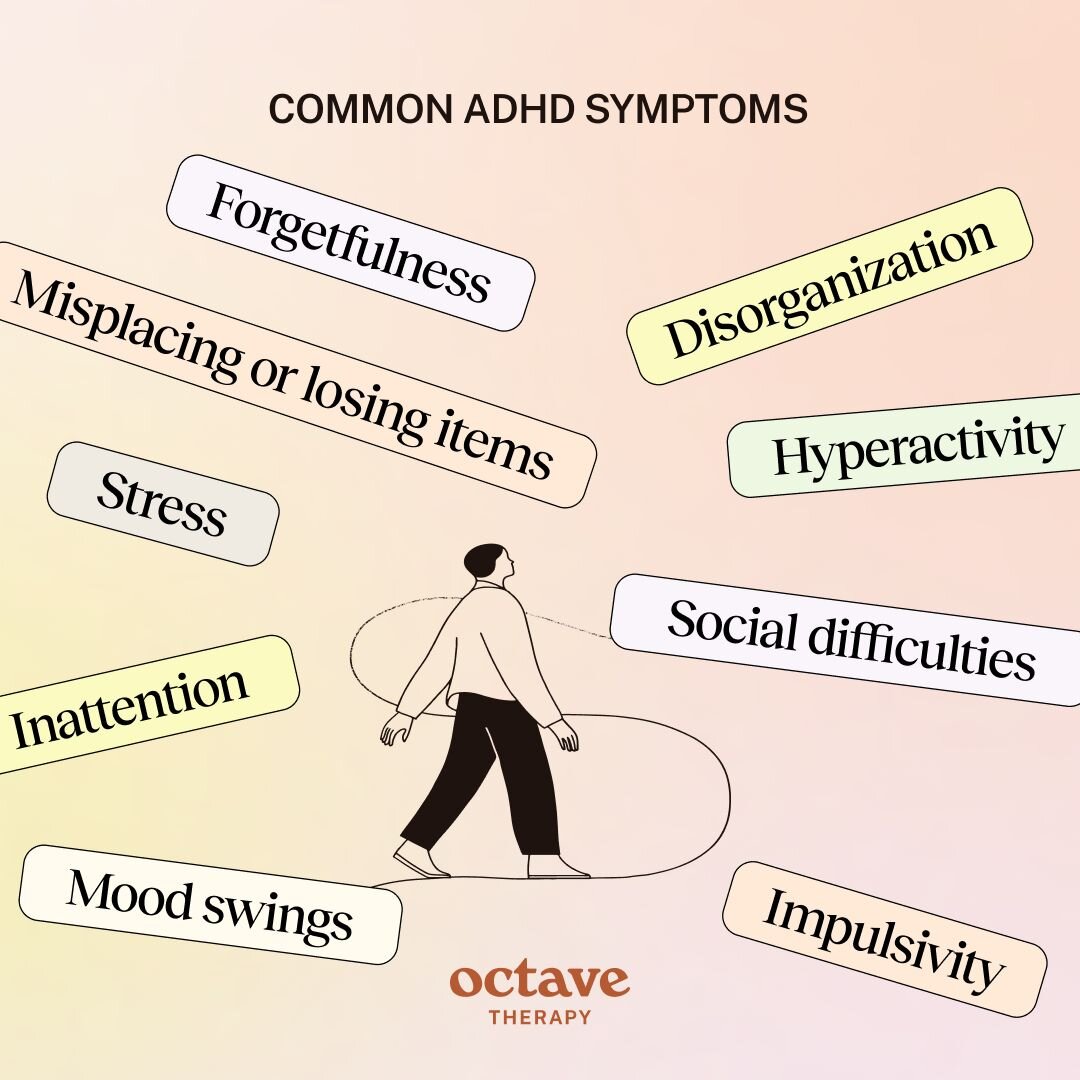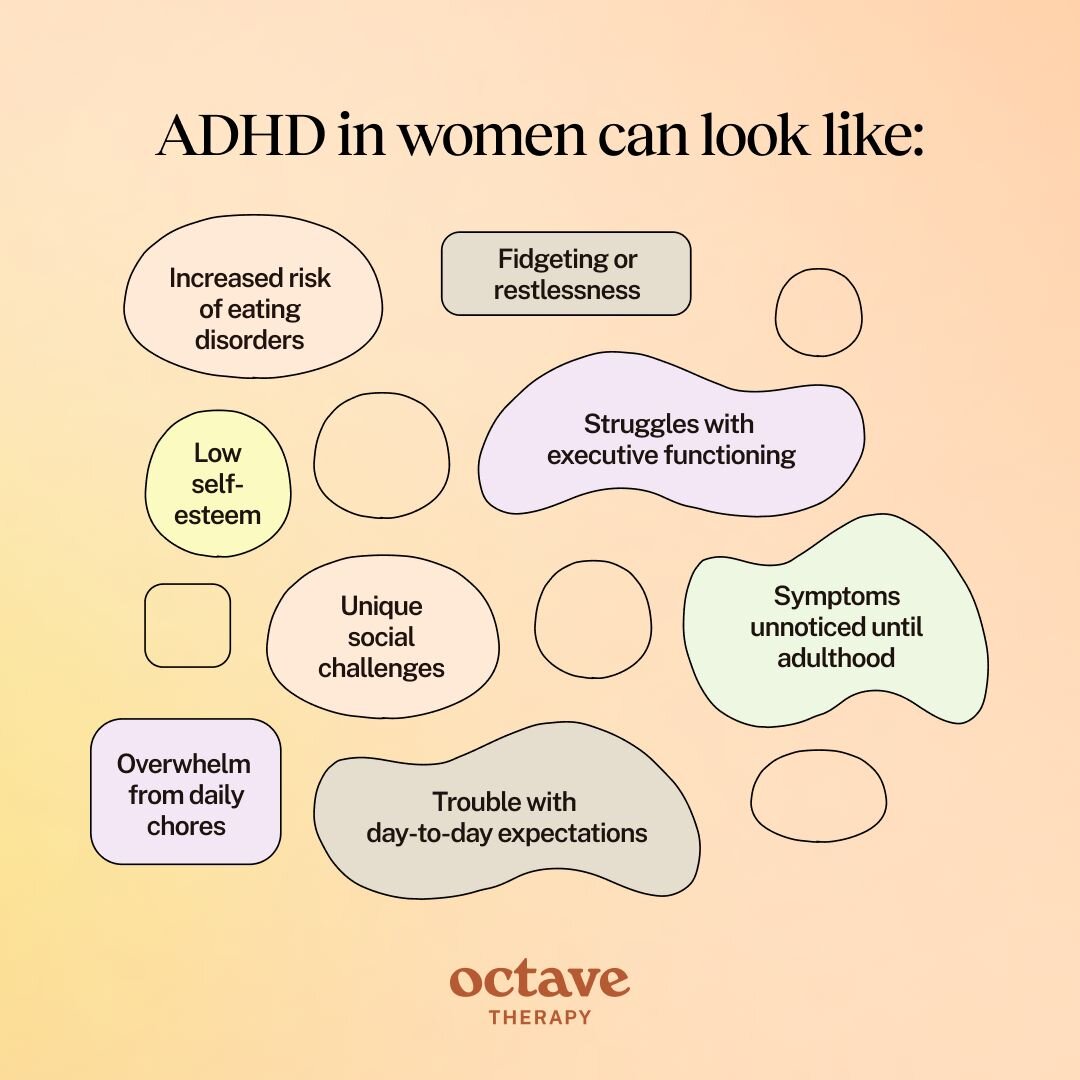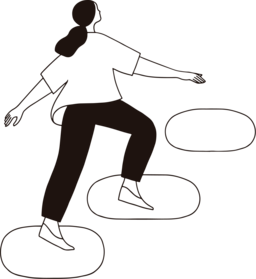
What is ADHD?
Overview
Living with attention-deficit/hyperactivity disorder (ADHD) can feel like always being slightly out of sync with expectations. You might struggle to follow along with group conversations, frequently find yourself searching for your car keys, forget to do assignments for work or school, and miss steps in tasks given with clear instructions.
On the flipside, you may find a unique way of solving a problem, only for bosses, coworkers, and peers to dismiss your solution simply because of how you got there. You end up striving to be like everyone else and berating yourself every time you fall short.
ADHD is a developmental disorder that can make it difficult to function effectively, whether in a domestic, academic, or professional setting. The fact that ADHD is so often misunderstood has led to many people not getting the help they need, while taking a toll on the self-esteem of those with the disorder.
The mischaracterization of ADHD has not always been limited to the broader public. It was only towards the end of the twentieth century that ADHD in adults was even recognized in the field of psychiatry.
This guide will answer the most common questions people have about ADHD, including:
- What is ADHD?
- What is the difference between ADHD and ADD?
- How do ADHD symptoms present in different groups of people?
- Which treatments are most effective for ADHD?
What is ADHD?
Attention-deficit/hyperactivity disorder (ADHD) is a developmental disorder that affects children and adults, most notably causing impairments with attention, hyperactivity, and impulsivity.
Although the causes of ADHD are still not entirely understood, it is widely considered to be rooted in differences in the brain and has a clear genetic component. These differences are responsible for disruptions in executive functioning, planning, and attention; movement; coordination and impulse control; dopamine regulation; and other functions.
ADHD was initially noticed in children in scholastic settings and was thought to resolve when the person reached adulthood. However, experts gradually recognized symptoms of ADHD in adults, not all of whom were diagnosed with the disorder as children. This led to the consensus that ADHD continues into adulthood and can significantly impede a person’s ability to perform necessary tasks, ranging from those required for day-to-day living, to academic and work responsibilities. Additionally, it impacts interpersonal relationships in ways that can feel embarrassing or distressing.
What is ADD?
You have likely heard the term attention deficit disorder (ADD) mentioned in the context of ADHD, referring to people who struggle with attention and other ADHD deficits but do not show hyperactivity. The term ADD is no longer used as commonly in the mental health field. Rather, the diagnosis of ADHD, predominantly inattentive presentation, is used, with increasing recognition that what was previously called ADD is actually a subtype of ADHD, rather than a separate diagnosis.
People with predominantly-inattentive ADHD are historically less likely to receive a diagnosis or treatment because their symptoms are not as disruptive in classrooms or households. They are often termed “under-achievers,” with parents and educators assuming that they are simply not interested in school work or are “lazy.” In reality, they are often expending a lot of energy in their attempts to study and behave like their neurotypical peers, with difficulties like procrastination and disorganization often being a source of significant distress.
The other two ADHD subtypes are:
- ADHD, combined presentation, in which the person experiences significant symptoms of both inattention and hyperactivity-impulsivity;
- ADHD, predominantly hyperactive/impulsive presentation, in which the person primarily displays symptoms related to difficulty controlling energy and physical activity levels. It is important to note, however, that a person diagnosed with primarily-inattentive ADHD may still experience some of the symptoms of primarily-hyperactive/impulsive ADHD, and vice-versa, even if they don’t meet criteria for combined-presentation ADHD.
What Are the Symptoms of ADHD?
There are a number of widely recognized symptoms of ADHD; however, ADHD can present differently for different people. Certain patterns are prevalent among various groups – gender, age, and environment each can play a significant role in how ADHD manifests.
ADHD symptoms affect a person’s activity, emotional regulation, executive functioning, and social interactions. While we will discuss the most prominent symptoms, it is important to keep in mind that different individuals may struggle with some symptoms more than others, adding complexity to the process of diagnosing ADHD.
ADHD Symptoms in Adults
Although it took decades before ADHD was recognized as a condition that continues into adulthood, this was not because the symptoms are necessarily less severe. In fact, some adults with ADHD report that their symptoms worsen as they age, especially if they did not receive treatment in childhood.
A potential reason for the worsening of symptoms in some adults is the increasing array of responsibilities that accrue through young and middle adulthood. Additionally, symptoms that do not impact achievement in childhood can become problematic in work environments and adult relationships.
In discussing the most common adult ADHD symptoms, we will provide examples of how they may present in adult contexts.
Common ADHD symptoms in adults include:
- Inattention: Difficulty paying attention, getting distracted, or having trouble focusing. The individual may lose track of a conversation regarding an important task or miss necessary details. They may be perceived as inconsiderate if they do not stay fully present during an interaction. This can complicate relationships with bosses and colleagues, as well as friendships and romantic relationships. When working on a complex or time-consuming task, trouble with focus and persistence can make the task more challenging. Frequent interruptions can lead the person to miss deadlines, whether personal or professional, potentially leading to self-criticism and conflict with others.
- Disorganization: Struggles with executive dysfunction creating difficulties in time management, organization, and planning. This can be particularly distressing in the context of important responsibilities, with the potential for negative consequences. The person might struggle to complete a project to an expected standard, despite having the knowledge and skills to do so. Staying on top of personal finances, including bills and taxes, can feel like a constant game of catch-up.
- Forgetfulness: The person forgets to do tasks they have committed to or which are basic responsibilities. People tend to have more commitments as they grow older and become responsible for things like home and car maintenance, personal accounting, childcare, and even keeping in touch with loved ones. As they gain experience in their work environment or advance in their career, they are trusted with more responsibilities, and it becomes difficult to keep track of everything required of them. Forgetfulness can also create tension in relationships, as loved ones may feel hurt by the forgetting of sensitive personal information shared in conversations, missed birthdays and anniversaries, or extended periods without contact.
- Misplacing or losing items is also common. In some cases, this is merely frustrating, as the person finds themselves constantly searching for their phone, car keys, or eyeglasses. In other cases, this can lead to financial loss or administrative headaches.
- Impulsivity: This is a well-known symptom of ADHD in children as the child interrupts teachers, parents, and peers, or seems to act without thinking. For adults, it can be even more problematic. When an adult interrupts others, it is often perceived as rudeness or arrogance. They may be taken to task by bosses or given the cold shoulder by colleagues. Loved ones might perceive these interruptions as a lack of consideration. Risk-taking can also be more consequential for adults, with misdeeds eliciting more serious consequences, whether legally or professionally. With more freedom than children, adults are also more likely to take actions that can temporarily or permanently harm themselves or others.
- Hyperactivity: This may present as restlessness or fidgeting. Sitting through a meeting may be a struggle, with some people with ADHD finding it necessary to leave their seat when a meeting drags on. Hyperactivity can also cause the person to remain “on the go” throughout the day, as they find it difficult to stay in one place or do one thing for an extended period of time.
- Mood swings: People with ADHD often have trouble with emotional regulation. This can cause the person to struggle to moderate painful emotions or maintain self-control when experiencing pleasurable emotions. They may also have a quick temper or experience irritability throughout the day.
- Stress: The symptoms of ADHD often lead to a sense of overwhelm for adults. This causes higher levels of stress. Struggles with emotional regulation and executive function create challenges in dealing with the stress in effective ways.
- Social difficulties: In addition to the ways that the above symptoms impact social interactions, people with ADHD often have trouble reading social cues and recognizing boundaries. They may be perceived as intrusive or oversharing, especially when excited by a topic. This can cause social anxiety and lead to self-imposed isolation in order to avoid rejection.
Although the above ADHD symptoms are common among adults, group differences can make a difference in how ADHD presents. Sex/gender, in particular, can impact how ADHD symptoms manifest.

ADHD Symptoms in Women
Some women with ADHD present similarly to men with the disorder. However, there are some differences that have been noted as common among women.
For many women, the hyperactivity connected with ADHD is more muted than it is among men, expressed more often in fidgeting and restlessness than disruption. This is thought to be a significant contributing factor to the phenomenon of ADHD being vastly underdiagnosed in women, especially during childhood.
Women with ADHD who do not present with significant hyperactivity are less disruptive in class, and teachers therefore tend to miss the signs of ADHD. In many instances, girls with ADHD manage a sufficient level of success in school – although they may be labeled underachievers – and their distress remains internal.
When they progress to college or work environments, their symptoms often become more problematic. Since women with ADHD tend to particularly struggle with executive dysfunction, they often find it difficult to keep up with expectations and responsibilities that their neurotypical peers find straightforward or intuitive. ADHD paralysis, triggered by challenges with organization, planning and working memory, anxiety caused by perfectionist tendencies, and emotional dysregulation, may become a significant stumbling block.
This struggle is expressed in life at home, as well. Women are still expected to take on and excel at housework to varying degrees, often depending on their community of origin. Completing day-to-day chores may be much more difficult for women with ADHD, and the expectation to do so can lead to a sense of overwhelm, paralysis, and shame.
Problems also seep into relationships and social interactions. Women are often viewed more harshly by society when presenting with rejection sensitivity, struggles with emotional regulation, and hyperactivity or restlessness. Many women with ADHD therefore experience greater challenges in social settings, while others find their energy drained in their battle to mask or suppress these symptoms.
This is also seen in the frequency of low self-esteem and feelings of inadequacy among women with ADHD, many of whom have internalized criticism of their symptoms of the disorder. These symptoms contribute to an increased risk of eating disorders, with restrictive behaviors around food appearing as a potential route to social acceptance, or simply something they can control. In other instances, food becomes a maladaptive way of self-soothing.

Why do Symptoms of ADHD in Women Present Differently?
Although it is certainly not true in every instance, symptoms of ADHD do present differently in many women with the disorder. There is no simple answer as to why this is the case, but evidence suggests it is due to a combination of biological, social, and diagnostic factors.
Hormonal differences contribute to the severity of certain symptoms, with higher estrogen levels affecting dopamine regulation and potentially accounting for low levels of motivation and energy. Gender norms also contribute to how ADHD in women presents, with girls more likely to mask their symptoms. This becomes a factor in the misdiagnosis of ADHD in girls who then do not receive treatment and may be left to suffer in silence.
ADHD Symptoms in Kids
ADHD can present differently in children than in adults, contributing to the misconception that adults are not affected by ADHD.
There are a number of possible reasons for the differences in how symptoms present in adults and kids. Adults have more experience masking their symptoms and are under greater societal pressure to do so. Physical factors, such as the natural decrease in energy levels as a person ages, also play a role.
Vastly different environments are another factor. Kids are more likely to spend time with large groups of peers, exposed to more stimuli and more opportunity for excessive talking and other social symptoms. Less routine, more novelty, and higher levels of peer pressure can enable or encourage impulsive behaviors.
ADHD symptoms in kids are generally split into three categories: inattention, hyperactivity, and impulsivity.
Inattention
- Difficulty paying attention to details
- Making careless mistakes
- Trouble sustaining attention in tasks or activities
- Easily distracted by external stimuli
- Forgetfulness in daily activities
- Difficulty following instructions
Hyperactivity
- Excessive fidgeting or squirming
- Difficulty remaining seated when necessary
- Running around or climbing inappropriately
- Difficulty engaging in quiet activities
- Talking excessively
Impulsivity
- Difficulty waiting for turn
- Interrupting others
- Acting without thinking
- Taking unnecessary risks
- Difficulty controlling emotions
Other Symptoms
- Difficulty sleeping
- Poor coordination
- Learning difficulties
- Interpersonal or social challenges
ADHD Medications & Treatment
ADHD does not go away on its own. Since it is a developmental disorder, there are symptoms that are lifelong. However, there are treatments for ADHD that help people with the disorder live fulfilling and meaningful lives.
It’s important to note that the aim of ADHD treatment is not to change the individual’s personality or ways of thinking and feeling. In fact, many people with ADHD express an appreciation of their unique approaches to life, even as they acknowledge the challenges. This has led to the emergence of the terms “neurodivergence” and “neurodiversity,” which focus on different ways of thinking rather than just the symptoms of the disorder.
However, ADHD treatment does serve an incredibly important purpose. Symptoms of ADHD can make facing daily life, whether at home, school, work, or in social situations, very challenging. This can create a sense of overwhelm, all too often leading to anxiety and depression. ADHD symptoms can also make it difficult to succeed academically or professionally, while complicating relationships, as well.
Treatment aims to facilitate effective functioning and reduce distressing or problematic symptoms. Additionally, it helps the person learn to integrate ADHD traits into a successful life, compensating for difficulties when necessary and optimizing strengths when possible.
ADHD is treated using medication, therapy, skills training, or a combination of approaches.
ADHD Medications
ADHD medications can help reduce the symptoms of ADHD, both in adults and kids. There are two main types of ADHD medications, stimulants and non-stimulants, which work in different ways in order to increase focus, attention, and impulse control. The most common ADHD medications include:
Stimulants
- Methylphenidate (e.g., Ritalin, Concerta, Focalin)
- Amphetamine (e.g., Adderall, Vyvanse, Dexedrine)
Non-Stimulants
- Atomoxetine (Strattera)
- Guanfacine (Intuniv)
- Clonidine (Kapvay)
Stimulants and non-stimulants are designed to achieve similar results. However, this does not make them interchangeable. Different people react better to some medications than others. Additionally, side effects can make the use of one or another medication less than ideal for an individual, depending on physiological, psychological, and environmental factors.
When determining which medication to prescribe, a psychiatrist will take the person’s context into account to ensure that they receive the most appropriate option.
How Stimulants Work
Stimulants work by increasing levels of dopamine and norepinephrine in the brain. These neurotransmitters play an important role in attention and focus. Higher levels can improve attention, reduce hyperactivity, and enhance working memory.
It is important to note that stimulants can be misused, leading to tight regulations regarding dispensation. You should only use stimulant medication prescribed by your licensed mental health provider.
How Non-Stimulants Work
Non-stimulant ADHD medications work using a different approach that achieves similar results. Rather than increasing the levels of neurotransmitters, non-stimulants modulate the activity of certain receptors, reducing overactivity of the brain signals that cause hyperactivity, impulse control dysregulation, and lack of focus.
ADHD Treatment
ADHD medications can be very effective at improving focus, attention, memory, and impulse control. However, there are other symptoms that can cause distress and disruption to the person’s life and are not reduced by medication.
Many people also prefer not to be solely reliant on long-term medication, especially in the face of potential shortages and other impediments to access. Some people with ADHD do not find a medication that works for them, and others may not be comfortable with potential side effects.
There are various ways to treat ADHD in combination with medication or in its place. These include:
Therapy
- A therapist specialized in ADHD can help the person learn to change distressing or distracting thought patterns; regulate emotions; deal with life challenges caused by the symptoms of ADHD; and learn healthy coping mechanisms. Cognitive-behavioral therapy (CBT) and dialectical behavioral therapy (DBT) are two of the most common therapy approaches used for ADHD.
- Therapy can also help people with ADHD learn to develop important life skills and habits, tailored to how their brain works, as opposed to attempting strategies that are at odds with how they think. This may include organizational skills, time management, structure, and regulating their environment.
Lifestyle changes
- Regular exercise, a healthy diet, and sufficient sleep can improve overall well-being and reduce ADHD symptoms. These habits do not come easily for most people and can be particularly difficult for those with ADHD. As such, it is important to ask for help when attempting to make these changes. Therapy is often a good space to receive guidance.
Neurofeedback
- This technique monitors a person’s brainwaves in real-time, helping them identify thoughts and behaviors that can improve focus.
In addition, the following approaches are often used for children with ADHD:
Parent training
- It is important for parents of children with ADHD to receive training on how to support their child's treatment. This helps them guide their child in a way that optimizes their strengths rather than highlighting their challenges. Traditional discipline or guidance can be counterproductive for kids with ADHD and may put them at risk of internalizing negative beliefs about themselves. With training, parents receive a toolkit for helping their child with effectiveness and compassion.
School interventions
- Teachers often struggle with kids with ADHD, becoming frustrated with those who display hyperactivity and disrupt class, and overlooking those who have internalized their challenges. Schools can improve conditions for both teachers and students by recommending helpful strategies, such as providing regular breaks, breaking down tasks into smaller steps, and using visual aids.
ADHD treatment is not one-size-fits-all. When you see a licensed mental health provider, they will work with you to create a personalized treatment plan ideal for your context.
Seeking Help for ADHD
Adults with ADHD, and parents of kids with ADHD, should seek help as soon as possible. ADHD is a complex developmental disorder that does not go away on its own. Its symptoms can be distressing and disruptive to life and can lead to additional issues, such as mood disorders, substance use disorders, and struggles managing responsibilities.
Treatment, whether with medication, therapy, or both, can help relieve the burden and help you learn to adapt and succeed while living with ADHD.
